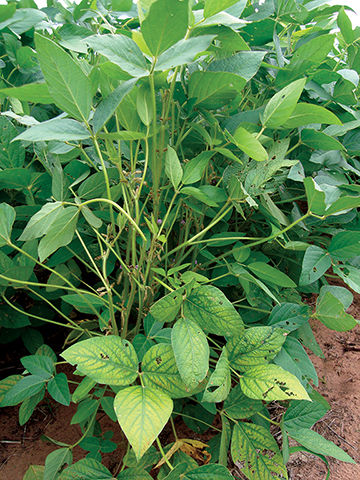Manganese Deficiency in Soybean
September 24, 2023
Though uncommon in most areas, soybean manganese deficiency (SMD) can be an issue in soybean fields with coarse soils or very high or low pH and result in yield loss. Manganese (Mn) is an essential micronutrient for soybean plants, playing a crucial role in various physiological processes such as photosynthesis, enzyme activation, and nitrogen metabolism. When soybean plants lack sufficient Mn, it leads to distinct symptomology, negatively impacting plant growth and overall productivity.
The symptomology of SMD manifests primarily in the youngest leaves of the soybean plant. These symptoms typically include interveinal chlorosis, where the tissue between the veins of the leaves turns yellow while the veins remain green (Figure 1). This yellowing may eventually progress to necrosis, causing the leaves to die and fall prematurely. Additionally, stunted growth, reduced flowering, and decreased pod formation are common indications of manganese deficiency in soybean.

The effect of Mn deficiency on soybean is detrimental to both yield potential and seed quality. Reduced chlorophyll production and impaired photosynthesis can result in lower energy production and yield potential. Poor flowering and pod formation lead to decreased seed set, resulting in fewer and smaller soybean pods.
The cause of Mn deficiency is often multifaceted. Soil factors, such as high or low soil pH and coarse soil texture can dramatically influence Mn availability to plants. Acidic soils (low pH) are more prone to Mn deficiency, as the nutrient becomes less soluble and less available to soybean roots. Furthermore, soil compaction and poor drainage exacerbate the problem by limiting Mn root access. Crop rotation patterns and residue management practices may impact soil Mn levels as well.
Long-term management and prevention of Mn deficiency is best managed with soil applications of Mn-containing fertilizers. For immediate remedy on acute deficiency situations, foliar applications of chelated Mn are most effective. Early detection of Mn deficiency is important to help mitigate its negative impact on soybean yield. Soil testing and regular monitoring of plant health can help identify potential deficiencies before they severely affect yield potential.
In summary, SMD can be a concern for some soybean fields. Understanding the symptomology, causes, and effects is essential for effective management. Timely application of Mn, either as foliar spray or soil amendment, tailored to the specific needs of the soybean crop, can help maintain healthy plants and help optimize yield potential.
Todd Vagts
Channel Agronomist
Sources:
Staton, M. 2023. Identifying and correcting manganese deficiency in soybeans. MSU Extension Soybeans. Michigan State University. https://www.canr.msu.edu/news/identifying_and_correcting_manganese_deficiency_in_soybeans.
Manganese (Mn) Deficiency of Soybean. Crop Protection Network. https://cropprotectionnetwork.org/encyclopedia/manganese-mn-deficiency-of-soybean
Web sites verified 8/14/23. 1110_279153